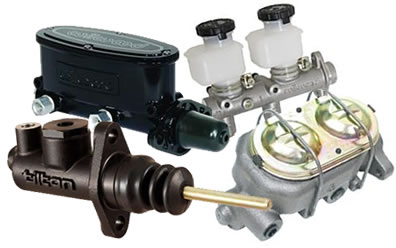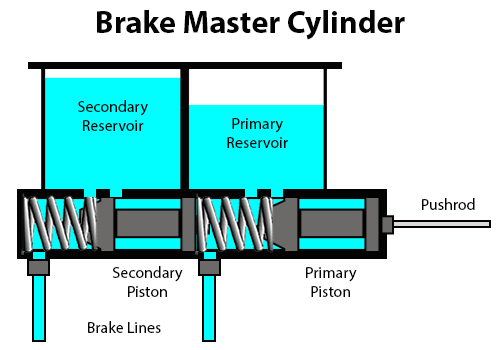
The Brake Master Cylinder is the heart of the braking system. It converts the force placed on the pedal into hydraulic pressure. Then, the pressure forces fluid through the brake lines and hoses.
For power-assisted brakes, the master cylinder is attached to the Brake Booster. The assembly is mounted on the firewall, in the engine compartment. The brake pedal is linked to the booster.
For manual brakes, the master cylinder is attached to the firewall and linked to the pedal.
How does it work?
Most master cylinders have a “tandem” design. This means the cylinder controls 2 hydraulic circuits. For safety, each circuit controls the brakes on 2 wheels. If 1 circuit fails, the other can still stop the vehicle.

Fluid reservoirs are located on top of the master cylinder. When properly filled, they keep air from entering the system.
When you press the pedal:
- The pushrod forces the primary piston to compress the fluid.
- As the piston moves, pressure builds inside the cylinder and lines.
- The pressure forces the secondary piston to compress the fluid in its circuit.
- Fluid is forced through the lines and engages the brakes.
When you release the pedal, springs return the pistons to their starting point. This relieves the pressure and disengages the brakes.
How does it affect performance?
One major factor in choosing a master cylinder is the cylinder diameter. Changing the diameter will affect the pedal feel and the system pressure.
- If the cylinder diameter is too large, it will create:
- Hard pedal feel (More effort required to press the pedal.)
- Short stroke (The pedal won’t travel very far before it creates enough pressure.)
- If the cylinder diameter is too small, it will create:
- Soft pedal feel (Less effort required to press the pedal.)
- Long stroke (The pedal will need to travel much farther to create enough pressure.)
Also, a small diameter cylinder may not create enough pressure to stop the vehicle. This is a risk with Disc Brake Conversion Kits. Drum brakes require less pressure. Therefore, master cylinders for drum brakes are usually smaller.
Some conversion kits include a new master cylinder. Check the Instructions before you buy. You may need to get a master cylinder separately.
The right size master cylinder will depend on the other components in the brake system and your preference of pedal feel. You will also need the right master cylinder for your configuration. So, there are master cylinders for:

